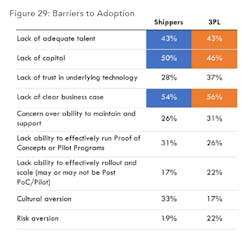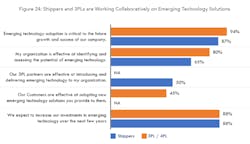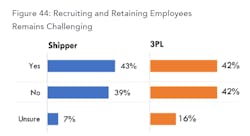How 3PLs, shippers are combating challenges with technology
Big supply chain challenges call for big changes from shippers and third-party logistics. According to an annual 3PL study conducted by Penn State University, Penske Logistics, and NTT DATA, logistics companies are implementing more technology and data to improve their business and automate operations within the supply chain.
The report, created by supply chain professor and researcher Dr. John Langley, surveyed shippers and 3PLs to examine how emerging technologies and data-driven approaches keep the supply chain flowing while navigating through a volatile economy and a talent crisis.
Implementing technology into logistics
It’s becoming more challenging to run a successful transportation or logistics business without technology. Technology is completely transforming many aspects of the industry, and those that don’t adapt will likely be left behind. Most of the industry agrees—94% of 3PLs and 87% of shippers think technology adoption is critical to their company’s success. However, only 45% of 3PLs and 50% of shippers believe 3PLs effectively introduce emerging technologies into their operations.
The study results outlined several barriers to technology adoption, and a lack of a clear business case for these technologies is one of the reasons, according to 54% of shippers and 56% of 3PLs. Other top reasons were a lack of capital for 46% of 3PLs and 50% of shippers, and finally, a lack of adequate talent for 43% of both 3PLs and shippers.See also: How The Custom Cos. uses tech to raise the bar
But those numbers don’t reflect a desire to become more technologically savvy. Shippers and 3PLs understand the need for technology to get a leg up on their competitors. According to the report, “shippers want end-to-end services, seamless experiences, proactive action, and data-driven insights” from their carriers and 3PL partners, and investing in technology is the only way to provide those services. One way to ensure these services and seamless experiences is through collaboration.
Shippers that work closely with 3PLs—according to the study, 80% said they are effective at identifying emerging technology’s potential, compared to 65% of shippers—will be able to hear from them what all is possible.
Andy Moses, SVP of sales and solutions at Penske Logistics, said 3PLs can advise customers against wasting time on technologies that, although “shiny” and “new,” don’t provide results. They can also help customers configure technology to meet the needs of a particular operation.Other technologies that 3PLs prioritize are used in warehousing. “Traditionally, 3PLs have had difficulty justifying large-scale investments in fixed-asset warehouse mechanization and automation,” Tom Tiede, managing director of supply chain operations at NTT DATA Supply Chain Consulting, said in the report. But over the last 10 years with the increased labor shortage and the advancements in warehousing technology, 3PLs have found more value in warehousing technologies, such as autonomous mobile robots used to automate the movement, storage, and retrieval of goods.
Fighting the labor shortage
Although 3PLs are using technology to combat labor shortages in the warehouse, not all open job positions can be replaced with robots. The report states that both shippers and 3PLs have experienced labor challenges, but shippers (78%) are feeling the impact more than 3PLs (40%). This has led companies to change the way they recruit workers, and it’s also led businesses to implement strategies to retain them.
See also: Modern fleet guide to raising retention and recruiting
“Among respondents, 61% of shippers and 58% of 3PLs said they’re having difficulty hiring hourly workers, down from 62% and 72% last year, respectively,” the report stated. “There’s also been an improvement in finding licensed hourly workers: 39% of shippers and 48% of 3PLs said they’ve had difficulty finding licensed hourly workers, down from 59% of shippers and 65% of 3PLs in the last study.”
Retention is also improving. Shippers (56%) and 3PLs (54%) reported improvements in retention over the last year. This could be due to retention strategies that were implemented, such as benefits packages, working conditions, and work-life balance, according to Mark Baxa, CEO of the Council of Supply Chain Management Professionals. Offering remote work positions was another strategy implemented by 48% of shippers and 45% of 3PLs. These numbers are up from 17% of shippers and 27% of 3PLs in 2022.
As previously mentioned, companies are implementing technology and automation in the workplace to make up for the lack of workers. According to the report, “16% of shippers and 32% of 3PLs said active implementation is ongoing, down from 48% and 38% last year,” which indicates that some companies may have already implemented these solutions. Additionally, shippers (37%) and 3PLs (30%) reported ongoing technology and automation research.See also: Continued supply chain challenges strain 3PL, shipper relationships
Download the report at 3PLstudy.com to find additional insights on 3PL-shipper relationships, supply chain optimization, and supply chain resiliency.
About the Author
Jade Brasher
Senior Editor Jade Brasher has covered vocational trucking and fleets since 2018. A graduate of The University of Alabama with a degree in journalism, Jade enjoys telling stories about the people behind the wheel and the intricate processes of the ever-evolving trucking industry.





